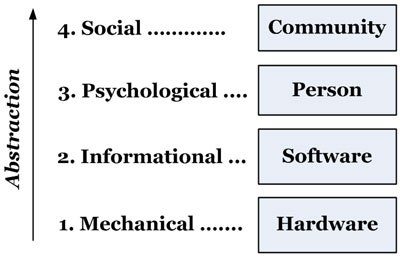 HCI began in the personal computing or PC era. Adding people to the computing equation meant that getting the technology to work was only half the problem — the other half was getting people to use it. Web users who did not like a site just clicked on, and only web sites that got hits succeeded. Given equal functionality, users prefer a more usable product (Davis, 1989); e.g. Word replaced Word Perfect because users took a week to learn Word Perfect but picked up Word in a day. Just as computing had previously gained a software level, so it now gained a human level.
HCI began in the personal computing or PC era. Adding people to the computing equation meant that getting the technology to work was only half the problem — the other half was getting people to use it. Web users who did not like a site just clicked on, and only web sites that got hits succeeded. Given equal functionality, users prefer a more usable product (Davis, 1989); e.g. Word replaced Word Perfect because users took a week to learn Word Perfect but picked up Word in a day. Just as computing had previously gained a software level, so it now gained a human level.
Human computer interaction (HCI) is a person using IT, just as IT is software using hardware. As computer science emerged from a combination of mathematics and engineering, so HCI is emerging from psychology and computer science. If psychology is the study of people and IT the study of software and hardware, then HCI is the study of psychology as it applies to IT. HCI is the child of IT and psychology. It links computer science to psychology as computer science linked engineering to mathematics. This new meta-discipline applies psychological principles to computing design; e.g. Miller’s paper on cognitive span suggests limiting computer menu choices to seven (Miller, 1956). The nature of people now defines the nature of computing; e.g. our many senses led to the multi-media trend.